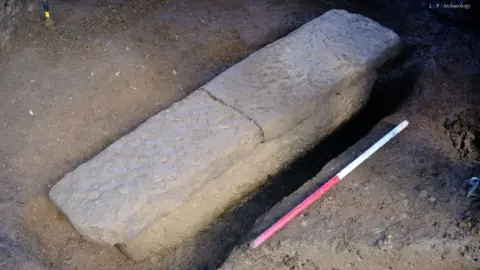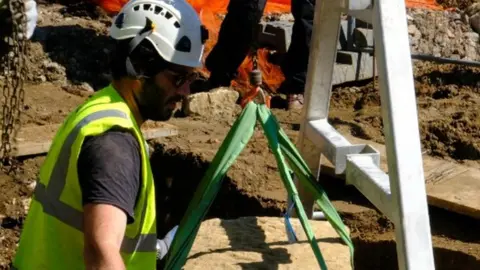Roman coffin found in Bath containing two skeletons
 L-P Archaeology
L-P ArchaeologyA Roman stone coffin containing the remains of two people has been unearthed at a city centre park.
The sarcophagus was found in Sydney Gardens, Bath, where excavations are under way as part of restoration works.
Small red and blue beads and a pot, possibly used to offer food as part of a pagan ritual, were also found.
Archaeologist Kelly Madigan said finding a skeleton inside a coffin was "a rarity" giving a "rare glimpse" into funerary practices 2,000 years ago.
Initial laboratory tests are being conducted and it is hoped that will lead to further analysis to learn more about who the people in the coffin were, where they were from and more about their general health and welfare, Ms Madigan, from LP Archaeology said.
"Having a human skeleton directly associated with a coffin is a rarity and to have this one associated with a probable votive offering and nearby human cremation, allows a very rare glimpse into funerary practices in the region almost two millennia ago."
Inside the casket and lid made of Bath limestone was a skeleton laid in a prone position and a second skeleton laid at their feet.
 other
otherThe casket was found in a grave about two metres (approx 6ft) long, 60cm wide and 50cm (about 23in to 19in) deep.
Its north-facing aspect suggests a pagan burial, experts said.
A cremation burial was also recovered and is the only recorded cremation burial from the Bathwick Cemetery to date.
Historic England advisor Sylvia Warman said: "This is a first for Bathwick and a really significant find for Roman Bath and the World Heritage Site.
"When completed, a scientific study of the remains will likely tell us much more about the lives, death and burial practices of the inhabitants of Roman Bath."
Initially a Roman wall was unearthed and as groundworks continued on the edge of the Bathwick Roman cemetery, the coffin was discovered.
Once testing has been completed the coffin could be displayed in the Temple of Minerva in the Botanical Gardens, Bath and North East Somerset council said.

Follow BBC West on Facebook, Twitter and Instagram. Send your story ideas to: [email protected]
